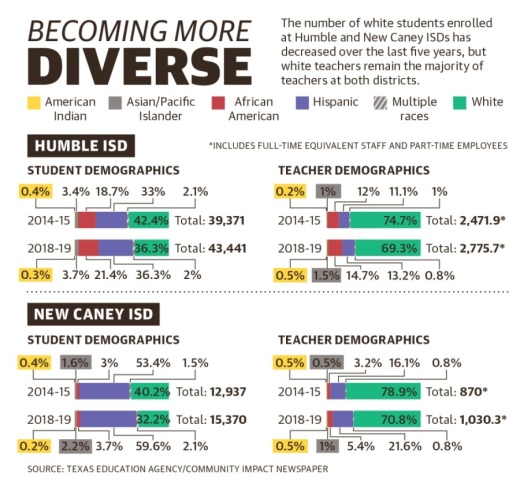According to 2018-19 data from the Texas Education Agency, 69.3% of Humble ISD’s teacher population was white that school year, while 36.3% of students were white. Moreover, 14.7% of teachers and 21.4% of students were Black, and 13.2% of teachers and 36.3% of students were Hispanic.
Similarly, at New Caney ISD, TEA data shows Hispanic students made up 59.6% of students but only 21.6% of teachers in the 2018-19 school year. Instead, NCISD teachers were mostly white at 70.8%, while 32.2% of students were white.
Diverse teacher representation can positively affect student outcomes and better set them up for future success, said Laura Owen, who serves as the director of the Center for Postsecondary Readiness and Success as well as a research associate professor at American University.
A 2017 study from the IZA Institute of Labor Economics found Black males from low-income families who had at least one Black teacher in third to fifth grade were 39% less likely to drop out of high school and were 29% more likely to pursue a four-year degree.
“We know that if our minority students have at least one same-race teacher, ... they do better on standardized tests; they have better attendance; they’re suspended less frequently,” Owen said. “If we do not have teachers of color who are on our staff who are working with our students, then we miss opportunities to question assumptions that we make about race and privilege.”
New initiatives, teacher hires
HISD began evaluating diversity, equity and inclusion policies this summer. Trustee Martina Lemond Dixon is the chair of the HISD Board and Superintendent Evaluation Committee, which is leading the initiative.
Dixon said via email that the committee has met twice so far to examine HISD’s policies and see if any upgrades are needed. She said they will not only examine racial equity, but also equity for other groups, such as students with special needs.
“We are targeting January to present information for the superintendent’s and board’s consideration,” she said.
Additionally, the demographic makeup of the district's new teacher hires have began slowly shifting over a four-year period to better reflect the student population. Community Impact Newspaper also requested teacher hire information from NCISD, but the information was not available by press time.
HISD data shows that the district hired more teachers of color in the 2019-20 school year than in 2016-17.
In the 2016-17 year, HISD hired 315 new teachers—64%, or 200, of whom were white and 22%, or 70, of whom were Black, which is the third-largest student population in the district. Comparatively, of the 442 new teachers HISD hired in 2019-20, 51%, or 226 new hires, were white, and 32%, or 141 new hires, were Black.
Data shows the percentage of new educators hired at the district who are Hispanic or Latino—which is the second-largest student population—has largely remained stagnant over the four years provided, ranging from 12%-14% of new hires. HISD Chief Communications Officer Jamie Mount said the district's recruitment strategy includes maintaining competitive compensation and benefits, offering professional development opportunities and recruiting at universities and job fairs, to name a few.
Scott Powers, NCISD’s executive director of public relations, said the district has an “inclusive” hiring process that includes university partnerships and virtual job fairs. However, he did not say if the district has any internal guidelines to ensure its staff reflects its student population.
“The district’s mission is to graduate students who are equipped to thrive in the reality of their future,” he said. “The district is dynamic in character and has worked to be responsive to the changing needs of students as this community grows.”
Powers said the district provides sensitivity training and professional training for bilingual teachers to build biliterate and bicultural classrooms.
An abridged version of this article was first published in the Lake Houston-Humble-Kingwood edition's September paper.







